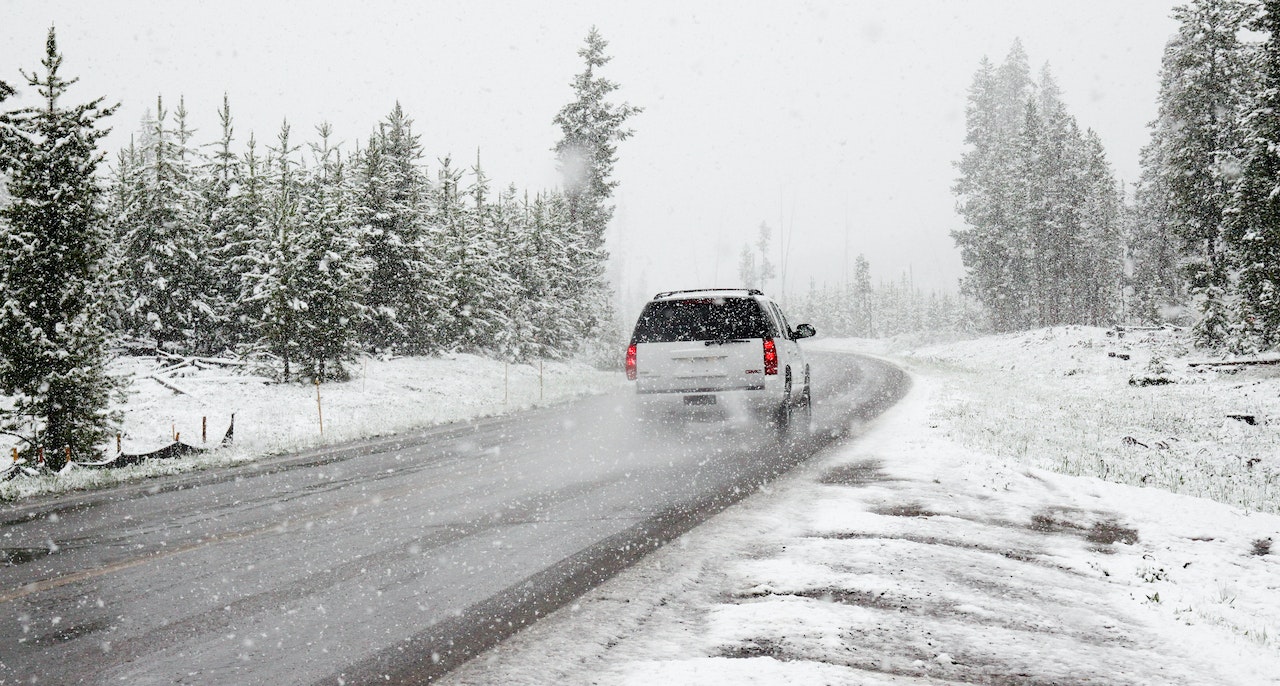Photo by: Chris Peeters
Driving in fall and winter can be hazardous due to a combination of adverse weather conditions and reduced visibility. During the fall, falling leaves can accumulate on roadways, becoming slippery when wet and potentially obscuring road markings and hazards. Moreover, rain and fog are common in many regions during the fall, reducing visibility and requiring drivers to adapt to rapidly changing road conditions. In winter, the primary hazard is the presence of ice and snow on the roads. These conditions can create treacherous driving surfaces, leading to decreased traction, increased stopping distances, and a higher risk of skidding or losing control of the vehicle. Additionally, reduced daylight hours mean that many commutes occur in the dark, further complicating driving conditions.
Beyond the weather-related hazards, fall and winter also bring other challenges. Reduced daylight hours and inclement weather increase the likelihood of driver fatigue and reduced alertness. Moreover, many animals are more active during the fall, increasing the risk of collisions with wildlife on the road. Overall, driving in fall and winter requires heightened caution, preparedness, and adherence to safety measures to mitigate these hazards and ensure safe travel on the road.
Preparing your vehicle for fall and winter driving is essential for several reasons:
- Safety: The foremost reason is safety. Fall and winter bring challenging driving conditions such as rain, snow, ice, and reduced visibility due to fog or early darkness. Proper vehicle preparation can help reduce the risk of accidents, collisions, and breakdowns, ensuring the safety of you, your passengers, and other road users.
- Vehicle Reliability: Cold temperatures can be tough on your vehicle. Preparing your car for winter can help prevent issues like engine problems, dead batteries, and frozen fluids, which can lead to costly repairs and leave you stranded in harsh conditions.
- Improved Traction: Winter tires or all-season tires with good tread depth can significantly improve traction on icy or snowy roads, reducing the likelihood of skidding or getting stuck. Properly inflated tires also provide better grip.
- Visibility: Clearing your vehicle of snow and ice before driving improves visibility, reducing the risk of accidents. Functional wiper blades and winter-grade windshield washer fluid are essential for maintaining a clear windshield.
- Emergency Preparedness: Winter conditions can lead to unexpected situations like getting stuck in a snowdrift or facing a road closure. Carrying an emergency kit and items like blankets, flashlights, and non-perishable food can be crucial for your safety in such situations.
- Peace of Mind: Knowing that your vehicle is in good condition and properly equipped for winter driving can give you peace of mind. You’ll be more confident on the road, which can reduce stress during your winter travels.
- Compliance with Regulations: In some areas, there may be legal requirements for certain vehicle preparations in winter, such as the use of winter tires or carrying specific safety equipment. Failing to comply with these regulations can result in fines or penalties.
- Responsible Driving: Being prepared for winter driving is a responsible and considerate action. It helps you avoid becoming a hazard to others on the road by reducing the chances of accidents caused by an unprepared vehicle.
Here are 10 ideas and tips to help you get ready for winter driving, including emergency preparedness:
- Check Your Tires:
- Inspect tire tread depth and consider getting snow or winter tires.
- Ensure tires are properly inflated; cold weather can affect tire pressure.
- Winterize Your Vehicle:
- Get a winter maintenance check-up, including brakes, battery, and heating system.
- Make sure your antifreeze is the correct ratio for freezing temperatures.
- Stock an Emergency Kit:
- Assemble an emergency kit that includes blankets, warm clothing, a flashlight, extra batteries, a first aid kit, and non-perishable food.
- Carry Snow Chains or Traction Mats:
- If you live in a particularly snowy area, invest in snow chains or traction mats to improve traction in icy conditions.
- Learn How to Install Chains:
- Practice installing snow chains before you need them so you’re familiar with the process.
- Keep Fuel Levels High:
- Try to maintain at least a half-tank of gas in your car to prevent fuel line freezing.
- Replace Wiper Blades and Fluid:
- Ensure your wiper blades are in good condition and use winter-grade windshield washer fluid to prevent freezing.
- Clear Snow and Ice Thoroughly:
- Before driving, clear all snow and ice from your windows, mirrors, lights, and roof to improve visibility and prevent hazards.
- Drive Defensively:
- Slow down and increase your following distance in slippery conditions.
- Brake gently and avoid sudden movements to prevent skidding.
- Stay Informed:
- Check weather forecasts and road conditions before traveling.
- Download a weather app or use GPS services that provide real-time updates on road conditions.
- Share Your Travel Plans:
- Inform someone of your travel route and estimated arrival time, especially for long journeys.
- Carry a Portable Phone Charger:
- Ensure your phone is charged and have a portable charger in case of battery drain during an emergency.
- Learn Basic Vehicle Maintenance:
- Understand how to change a flat tire and jump-start your car.
- Keep a Shovel and Sand/Kitty Litter:
- These can help you dig out if you get stuck in snow or ice.
- Consider a Roadside Assistance Plan:
- Having a roadside assistance plan can be invaluable during winter emergencies.
In summary, preparing your vehicle for fall and winter driving is not only about your personal safety but also about being a responsible driver and ensuring the well-being of others on the road. It’s a proactive step that can help you avoid accidents, breakdowns, and discomfort during the colder months.



